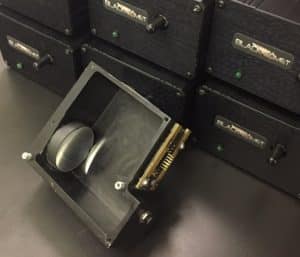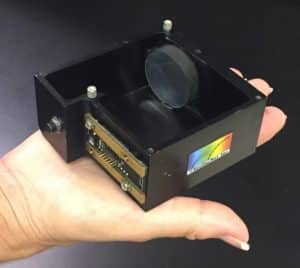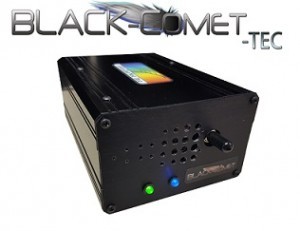
We had the opportunity to speak with Michael Newel, Lead Optical Engineer at StellarNet, to give insight into our BLACK-Comet Concave Grating.
What is the BLACK-Comet and what are its advantages?
The BLACK-Comet tackles limitations of traditional Czerny-Turner designs for UV-VIS spectroscopy by offering:
- Field curvature correction: A concave holographic grating ensures a flat field on the detector, minimizing resolution variations across the spectrum.
- Minimized stray light: The simplified optical architecture significantly reduces stray light, particularly crucial in the UV regime.
- Enhanced sensitivity: The collection area, f-number and grating blaze pattern translate to higher broadband sensitivity.
This combination translates to accurate spectral data, particularly valuable for research demanding high-fidelity measurements across the UV-VIS range and in low light applications.

Check out our Technical Note on Concave Grating Optics
What is Field Curvature and how does the BLACK-Comet address the problem?
Field curvature, a prevalent challenge in spectrometers equipped with flat gratings, arises from the varying diffraction angles experienced by stray light rays entering the grating at different off-axis positions (emanating from different regions of the entrance slit). This phenomenon leads to a curved focal plane where the dispersed light strikes the detector, resulting in non-uniform resolution across the captured spectrum.
The BLACK-Comet spectrometer addresses this issue through the implementation of a variably spaced grating. By strategically modifying the groove spacing across the grating area, we achieve the following:
- Flattened Focal Plane: The variation in groove spacing compensates for the angular dependence of diffraction, effectively “flattening” the focal plane. This ensures consistent resolution for all wavelengths across the detector, regardless of their initial incident angle or the grating. [1]
- Aberration Control: The tailored groove spacing profile also mitigates the introduction of both astigmatism and spherical aberration within the diffracted light. This optimization minimizes image distortion and maintains a high degree of spectral fidelity. [2]
This innovative grating design, essentially a type of variational polychromator, allows the Black Comet to overcome the limitations of field curvature typically associated with flat gratings. The resulting flat focal plane ensures exceptional resolution uniformity across the entire and reliable spectral data.
What is Stray Light and how is it minimized in the BLACK-Comet?
Stray light, a persistent foe in spectrometer design, can significantly compromise measurement accuracy. It arises from three primary sources:
- Surface Scatter: Imperfections on optical surfaces, such as roughness or contamination, can cause unwanted light scattering into unintended paths. [3]
- Diffractive Scattering: The diffraction grating itself can generate stray light. Higher diffraction orders and imperfections within the grating can diffract light outside the desired spectral order. [4]
- Internal Reflections: Every reflective surface within the instrument presents an opportunity for stray light generation. Light reflecting off these surfaces can scatter or re-enter the optical path, contributing to the background noise. [5]
The BLACK-Comet spectrometer tackles these challenges through a two-pronged approach:
- Minimized Optical Elements: A simplified optical design with fewer optical components inherently reduces the number of reflective surfaces. This minimizes the potential for stray light generation due to internal reflections.
- Holographic Grating Technology: Employing a holographic grating, manufactured with a superior level of precision, minimizes imperfections that could contribute to diffractive stray light. This advanced grating technology ensures cleaner spectral separation and reduces the background signal caused by stray light.
By implementing these strategies, the BLACK-Comet achieves exceptional stray light performance, particularly crucial for measurements in the UV region where stray light can be more prominent. This translates to cleaner data and improved confidence in the measured spectra.

BLACK-Comet Optics- The concave holographic grating is aberration corrected and has no mirrors to minimize stray light with superb imaging projecting a flat field on the detector
Could you tell us more about the BLACK-Comet’s sensitivity and how it impacts measurements?
Sensitivity in a spectrometer directly translates to a favorable signal-to-noise ratio (SNR), a crucial parameter for accurate spectral analysis. Here, we explore key design considerations to maximize SNR:
- Increased Throughput: A larger collection area and a faster f-number system work in tandem to gather more photons, effectively boosting the signal strength at the detector. This enhanced throughput becomes particularly important for weak UV signals.
- Efficient Grating Design: A sinusoidal blaze grating plays a critical role. Its optimized profile efficiency channels diffracted light towards the detector, maximizing the usable signal and minimizing wasted photons.
- Minimized Optical Losses: A mirror-free architecture represents a significant advantage. By eliminating reflective surfaces, this design strategy minimizes internal light losses within the instrument. This ensures a higher proportion of incoming light reaches the detector, further improving the overall signal strength.
In essence, these design features synergistically contribute to a high-sensitivity spectrometer. A strong signal relative to the inherent noise floor allows researches to discern the true spectral signature from random fluctuations. This translates to highly accurate and reliable data, especially for challenging low-light measurements in the UV regime. By maximizing SNR, researchers gain the ability to “see” fainter spectral features, leading to a more comprehensive understanding of the sample under investigation.
Are there potential improvements for the BLACK-Comet on the horizon?
The BLACK-Comet spectrometer has established itself as a leader in minimizing stray light, particularly valuable in the UV region. However, for researchers venturing into even more demanding UV applications, further advancements can be explored. Here, we propose a two-pronged approach to enhance the BLACK-Comet’s UV sensitivity:
- Grating Optimization:
- Blaze profile refinement: Tailoring the blaze profile of the diffraction grating can improve light dispersion specifically within the UV regime. This allows for more efficient light distribution at these shorter wavelengths. [6]
- Increased groove density: Employing a grating with a higher groove density enhances resolution for UV wavelengths. This enables researchers to resolve finer spectral features and distinguish closely spaced peaks. [7]

- Increased Light Collection:
- Faster f-number: A system with a lower f-number increases the overall light collection efficiency. This translates to a stronger signal at the detector, particularly beneficial for faint UV signals. [8]
Beyond the Grating: Detector Integration
- Combining the BLACK-Comet with an ultra-cooled detector like the HYPER-Nova presents a compelling possibility. This powerful combination would offer unmatched sensitivity for low-light UV measurements. The HYPER-Nova’s significantly reduced thermal noise would further amplify the weak UV signals, leading to superior detection limits.
Sources
- [1] Horace 1. Smith, “Design of Diffraction Gratings for Spectroscopic Purposes” (Journal of the Optical Society of America (1917-1935), Vol. 26, No.1, 1936, pp. 19-24) (https://onlinelibrary.wiley.com/doi/full/10.1107/S1600577520008292)
- [2] Emilie Trouille et al., “Efficiency and Aberrations in Holographic Gratings with Varied Groove Spacing” (Applied Optics, Vol. 41, No. 1, 2002, pp. 13-20) (https://apps.dtic.mil/sti/pdfs/ADA293169.pdf)
- [3] Little Vancitation, John Decker, “Introduction to Spectrometers” (Oxford University Press, 2000)
- [4] Eugene Hecht, “Optics” (5th Edition, Addison Wesley, 2002)
- [5] Wilhelm Urbanczyk, “Reflectance Spectroscopy” (Elsevier, 2011)
- [6] William R. McKinney et al., “Efficiency of echelette gratings for near-normal x-ray diffraction” (Applied Optics, Vol. 27, No. 4. 1988, pp. 780-785) (http://people.whitman.edu/~dunnivfm/FAASICPMS_Ebook/Downloads/CH1FINAL.pdf)
- [7] Eugene Hecht, “Optics” (5th Edition, Addison Wesley, 2002) (Chapter 11: Diffraction)
- [8] Warren J. Smith, “Modern Optical Engineering” (4th Edition, McGraw-Hill Education, 2007) (Chapter 3:Lenses)





